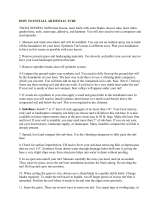Page is loading ...

HOW TO INSTALL
ARTIFICIAL TURF
INSTALLATION
AND MAINTENANCE
Step 1: Excavation & Existing Sprinkler Removal
Remove 4”- 6” of dirt below the level at which you want the turf.
Beware of irrigation and electrical lines which may be located under
the project area. Either completely remove sprinkler lines or remove
and cap sprinkler heads. Cap sprinklers at the level as opposed to
the rising to avoid any leakage that may occur between the two.
Step 2: Base Preparation
After removing the dirt, compact the soil using a 5000lb plate
compactor. This will increase the soil’s load bearing strength and
prevent settling. Then, install a weed barrier on top. If desired, lay
down gopher wire and use landscape staples to hold it in place.
Do not install plastic under the turf as it will entrap water, causing
other problems.
Step 3: Compacting Base
Place base material over the weed barrier and compact it in 3”=4”
increments. Water can be added to assist in compaction. Once again,
use a 5000lb plate compactor to compact the base. The base
material should be a crushed gravel that varies in size from ¾” to dust
and may be fortied with a small amount of cement to stien after
installation. Ensure you slope the base away from the house and
towards drainage area.
Step 4: Turf Layout
Ensure to measure the project area and carefully design the layout to
minimize the number of seams in the turf. Unroll the turf and
stretch across the top of the prepared base. Make sure not to drag it
across. If the synthetic turf has a wrinkle; allow it to acclimate in the
sun. Due to the natural direction of the turf blades, separate pieces
of turf must be laid in the same direction.
Step 5: Turf Cutting
Cuts can be made using a long pile carpet cutter or a carpet knife.
All cuts must be made from the backside of the turf. This will ensure
you see the stitched rows.
Step 6: Secure the turf
Secure the turf by staking the edges with 6 inch nails. Place the
nails six inches apart. Nails used in the eld should be applied as
necessary to prevent movement of turf.
Step 7: Seams
You can choose the seam 2 straight edges together or use the “S” cut
method using a custom stencil. Either way, make sure the stitch lines
match so the seams will be practically unseen. The “S” cut method
is a more advanced process, but may give you a more natural
appearance. Once you have your seams cut, straight or “S”, pull both
pieces of turf back exposing the base. Place the seam tape with
half of the tape under each cut. Use a synthetic turf adhesive and
apply to the seam tape. Fold the two sections of articial grass over
seaming material to form one seamless piece. Secure seams with
U-nails spaced six inches apart.
Step 8: Tucking Turf Edges
Tucking the turf involves hiding the edges of the turf against any
hardscape or edging boarder by using a wonder bar. The side edges
of the turf give it a good clean plush look.
Step 9: Applying Filler
Spread Wonderll material evenly utilizing a drop spreader (the type
commonly used to spread grass seed), or a at. Do not attempt to
install the inll material while the synthetic grass or the inll material
is wet. Once all sand is spread evenly on top of turf it will need to
be broomed into the turf bers. Use a power broom to brush up turf
bers and let the sand work in between the turf blades. When the
inll process is complete, water the entire area evenly with a hose to
settle the material. This acts as a balance to hold the blades upright
and gives the turf more weight.
Step 10: Final Groom
The nal grooming step involves power brushing the turf once again,
lightly, to force the wonderll granules into the base of the turf for
settling and optimal stability.
DON’TS
CLEANING & BRUSHING
straight. Areas exposed to high trac may require more brushing.
Brush the grass against the grain in high trac areas. Brushing
against the grain will help avoid matting.
Never use a power washer. It is recommended to use a hose with
sprinkler or spray nozzle, this will allow the water to drain.
Use a rake or leaf blower to clear o fallen leaves, branches, and
other rotting debris that may land on top of their articial turf.
Regularly remove these materials. Spray down your articial turf
surface with a hose to remove dust.
Articial turf is safe for pets and cleaning up after your pet is easy.
Use a pooper-scooper to remove the feces from the turf. Following
pickup, hose down the area that has been exposed to feces or urine.
Brush your turf with a sti broom to keep the blades standing up
Be sure not to expose turf to any extreme heat that can be created
by reective glass. This may magnify the sunlight and burn the turf.
Keep any kind of ames away from the turf.
/






